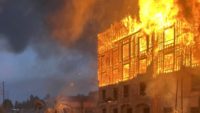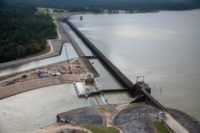Investigators are trying to find the cause of a massive fire that destroyed an apartment building under construction in Oklahoma City earlier this week.
The fire is one of a series of wood-framed apartment building construction fires in recent years that has drawn attention from insurers, risk managers and contractors.
Local fire department officials deemed the nearly complete, 325-unit Canton at Classen Curve apartment building, valued at $65 million, a total loss.
Only specialized areas of the 369,000-sq-ft structure, those featuring post-tensioned concrete decks, were not wood-framed. The first phase of the three-phase project had been completed and turned over to the developer, and the first tenants were scheduled to move in next month.
Hines, the Houston-based real estate company, and Humphreys Capital, an Oklahoma City investment firm, were the project's developers.
The fire suppression system and a standpipe system, designed to deliver water to the building's upper floors for use by firefighters, were only operational in the development's completed first phase.
—Oklahoma City Fire Dept.
When the fire department arrived at 6:33 pm on Tuesday, smoke and fire were already visible on the structure's roof.
The fire suppression system and a standpipe system—designed to deliver water to the building's upper floors for use by firefighters—were only operational in the development's completed first phase. Neither of the systems were working in the rest of the structure.
Fire officials noted that a roofing material they identified as made of thermoplastic polyolefins (TPO) seemed to intensify and spread the fire. Once the blaze reached the roof it quickly began to spread across the structure.
TPO is "very difficult to ignite but once it is ignited it is very difficult to extinguish,” said Capt. Scott Douglas of the Oklahoma City Fire Department. His characterization of the material could not immediately be confirmed.
The intense heat and fire and 2 million gallons of water poured into it by firefighters compromised the apartment building's structural integrity and force firefighters out.
“The building deteriorated pretty quickly,” Douglas said. “Just a few hours in we removed everyone from interior operations and conducted defensive operations only.”
As a five-story, wood framed structure, the building was classified as Type III under the International Building Code (IBC). That type requires the exterior load-bearing walls wo be fire-rated with the goal of containing any fire within the building's exterior walls and mitigating any spread.
Additionally, the structure was divided into multiple individual code-regulated buildings. These individual sections were separated with walls made of autoclaved aerated concrete with a three-hour rating. According to fire department officials, they found not code violations.
Past Wood-Framed Structures Burned
The size and intensity of the fire is reminiscent of past blazes at wood-framed apartment construction sites that have prompted safety concerns. The National Fire Protection Association says that wood-framed apartment complexes under construction pose a unique fire danger and stringent safety standards must be maintained throughout the building process.
NFPA recommends the creation of an overall construction fire-safety program and designating a fire prevention manager for construction. The problem is that each project presents specific fire-safety issues which must be identified and addressed.
“There is not a black-and-white answer, or we probably would have solved this years ago,” said Val Ziavras, technical services engineer with NFPA. “So much depends on each individual site and the specific requirements needed to maintain safety.”
In the past, similar fires have led officials to focus on the building material—specifically wood—as the primary culprit behind the blazes. Paula Cino, vice president of construction, development and land-use policy at the National Multifamily Housing Council says that approach can obscure more productive fire-mitigation strategies.
Fire-Prevention Partnership Needed
“Fundamentally, something like safe security and planning have to be a big part of the conversation,” she said. “Really the key here is partnership and responsibility lies with the owner, the developer, the contractor and all the subcontractors.”
The fire protection group's standard for fire prevention during construction, NFPA 241, ensures that fire safety standards are maintained throughout the building process. It requires building owners to create an overall construction fire safety program and designate a fire-prevention manager for the construction process.
Execution is important, too, Ziavras explained. “Having a plan is one thing, but then you have got to have communication and execution.”





Post a comment to this article
Report Abusive Comment